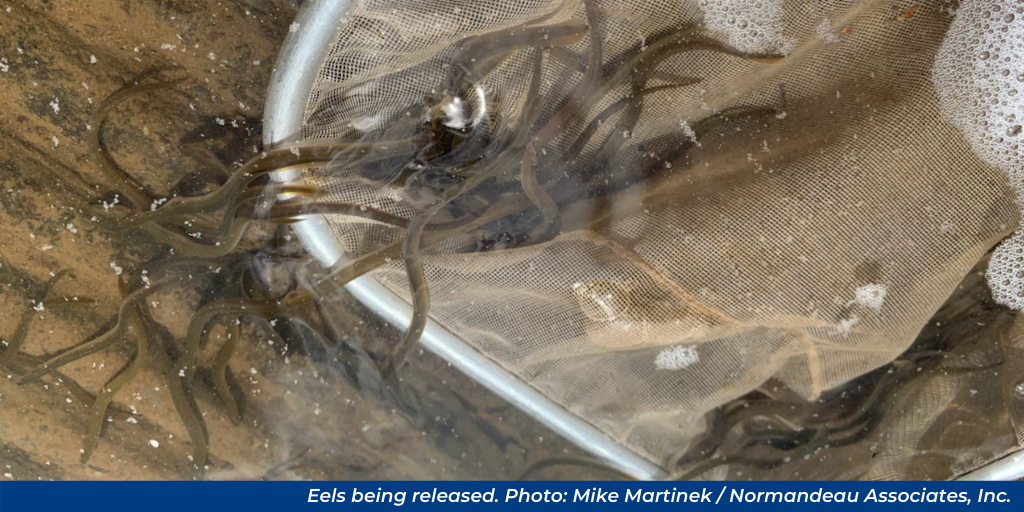For many years, hydroelectric dams have prevented American Eels from migrating up the Susquehanna River. Recognizing the importance of eels to the ecosystem, the Pennsylvania Department of Environmental Protection (DEP) and its partners have come to their aid by transporting them past the dams and upstream, where their symbiotic relationship with mussels helps to improve water quality in the Susquehanna River and the Chesapeake Bay.
The Remarkable Migratory Journey of the American Eel
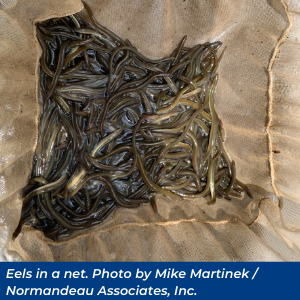 Eel migration has been described as a rather romantic tale. The American Eel begins life in the Sargasso Sea in the middle of the North Atlantic Ocean. Carried by the Gulf Stream, young eels, known as elvers, make their way to freshwater habitats including the Chesapeake Bay and the Susquehanna River. After reaching maturity in 10 to 15 years, adult eels migrate downstream returning to the Sargasso Sea. There, they spawn for the first and only time in their lives and then die. But during its relatively brief lifetime, the American Eel plays a vital role in the ecosystem, including acting as a host species for Eastern Elliptio Mussels, the most common freshwater mussel found in the Susquehanna River. This relationship is important because
mussels naturally filter water which improves water quality in places like the Susquehanna River and the Chesapeake Bay.
Eel migration has been described as a rather romantic tale. The American Eel begins life in the Sargasso Sea in the middle of the North Atlantic Ocean. Carried by the Gulf Stream, young eels, known as elvers, make their way to freshwater habitats including the Chesapeake Bay and the Susquehanna River. After reaching maturity in 10 to 15 years, adult eels migrate downstream returning to the Sargasso Sea. There, they spawn for the first and only time in their lives and then die. But during its relatively brief lifetime, the American Eel plays a vital role in the ecosystem, including acting as a host species for Eastern Elliptio Mussels, the most common freshwater mussel found in the Susquehanna River. This relationship is important because
mussels naturally filter water which improves water quality in places like the Susquehanna River and the Chesapeake Bay.
But early on in their migratory journey, eels face man-made challenges in the Susquehanna River which not only impede their progress, but also threaten their existence in the entire Susquehanna River Basin.
Caution: Roadblock Ahead
American Eels are native to Pennsylvania waters and at one time they were plentiful in the Susquehanna River. However, massive hydroelectric dams built during the 1900’s effectively closed the river to migratory fishes, including the eel. While eels can climb remarkable heights, the 94’ Conowingo Dam located on the lower Susquehanna River in northern Maryland proved insurmountable for the elvers. Without elvers making their way up the Susquehanna, eels basically disappeared from the Susquehanna River Basin in Pennsylvania. And without eels to use as a host species, mussel populations in the upper regions of the river also became nearly extinct.

The Link Between the American Eel and the Eastern Elliptio Mussel
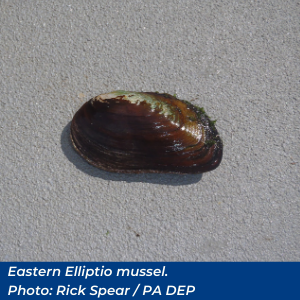 Freshwater mussels rely on certain fish species, including eels, to reproduce. During the final stages of reproduction, female mussels emit a parasitic larva (glochidium) which attaches itself to the gills of an eel, its favorite host. The larvae drop off after 2 to 4 weeks to grow into juvenile mussels and finally, adult mussels which have lifespans of up to 100 years. Since mussels continuously pump water through their bodies, an adult mussel can filter and clean up to 15 gallons of water each day making their presence vitally important to the health of Pennsylvania’s rivers and streams.
Freshwater mussels rely on certain fish species, including eels, to reproduce. During the final stages of reproduction, female mussels emit a parasitic larva (glochidium) which attaches itself to the gills of an eel, its favorite host. The larvae drop off after 2 to 4 weeks to grow into juvenile mussels and finally, adult mussels which have lifespans of up to 100 years. Since mussels continuously pump water through their bodies, an adult mussel can filter and clean up to 15 gallons of water each day making their presence vitally important to the health of Pennsylvania’s rivers and streams.
The presence of mussels or lack thereof, is one indicator of water quality and also of society’s impact on their habitat since they are especially susceptible to many pollutants and contaminants. In the early 2000’s scientists discovered that while mussels were plentiful in the upper Susquehanna River, their population was aging. Without the presence of eels to assist with their reproduction, fewer mussels were being born and thus faced extinction in some areas of the Susquehanna. Recognizing the problems dams and other hydroelectric facilities posed to eel migration and the benefits eels provide to the ecosystem, DEP worked with dam owners as part of their recertification process to provide passageways for eels and also to catch and transport them past the dams.
Catch and Release: Hydroelectric Facility Recertification Helps Eels Detour Past the Roadblocks
Dams and other hydroelectric generation facilities must periodically undergo recertification, a process which includes assessing the ecological impacts of operation and how they can be mitigated. One such facility is the Muddy Run Pumped Storage Project (Muddy Run). Muddy Run is a hydroelectric power plant located in Lancaster County which was previously owned by Exelon Corporation. (Muddy Run is currently owned and operated by Constellation Energy Corporation.) Operation of this facility entraps the American Eel as well as other aquatic species. Among the conditions for DEP issuing a water quality certification to the facility in 2014, Exelon was required to implement a program to trap up to one million eels per year from below the Conowingo Dam in Maryland and in the Octoraro Creek in Pennsylvania, and release them to multiple locations in the Susquehanna Watershed in Pennsylvania.

In 2015, Exelon installed eel trapping facilities along the western shore of the Conowingo Dam and at Octoraro Creek below the Chester Water Authority Dam in southern Chester County, PA. The collection devices consist of a ramp-style trap leading to a collection tank at the top of the ramp. From the collection tank, the eels are then transferred to holding tanks where they stay until being transported upstream. Next the eels are moved from the holding tank to a transport vehicle equipped with an insulated container that is covered and aerated. The eels are then taken to locations along the Susquehanna River and released.
This most recent eel stocking effort builds upon similar efforts taken by the PA Fish and Boat Commission (PFBC) during the 20th Century and more recently by the US Fish and Wildlife Service.
Early Results in Restoring Eel and Mussel Populations Are Promising…
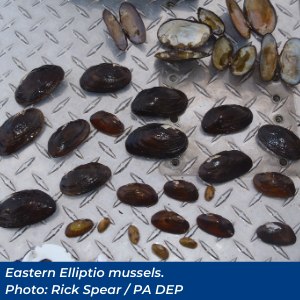 In 2020, over 250,000 eels were captured and released into the Susquehanna River. The stocking efforts in 2021 were even more remarkable as over 660,000 elvers were collected and transported to stocking locations in the Susquehanna River Watershed. The success of past and current efforts in trapping and transplanting eels has become evident. DEP staff performing field work in the West Branch Susquehanna River and its tributaries have seen a dramatic increase in eel populations in recent years. Other agencies such as the Susquehanna River Basin Commission and the PFBC are seeing similar results. Some eels have been recaptured as far as 140 river miles from the nearest release location. Eels have now been observed in the headwaters of the Susquehanna River near Cooperstown, New York. Additionally, researchers monitoring tributaries that were stocked with eels have noted the presence of young Eastern Elliptio mussels where they were previously absent.
In 2020, over 250,000 eels were captured and released into the Susquehanna River. The stocking efforts in 2021 were even more remarkable as over 660,000 elvers were collected and transported to stocking locations in the Susquehanna River Watershed. The success of past and current efforts in trapping and transplanting eels has become evident. DEP staff performing field work in the West Branch Susquehanna River and its tributaries have seen a dramatic increase in eel populations in recent years. Other agencies such as the Susquehanna River Basin Commission and the PFBC are seeing similar results. Some eels have been recaptured as far as 140 river miles from the nearest release location. Eels have now been observed in the headwaters of the Susquehanna River near Cooperstown, New York. Additionally, researchers monitoring tributaries that were stocked with eels have noted the presence of young Eastern Elliptio mussels where they were previously absent.
In addition to the water quality benefits of mussel populations, recent studies suggest that the eels are helping to ecologically balance aquatic benthic communities, such as preying on the invasive Rusty Crayfish.
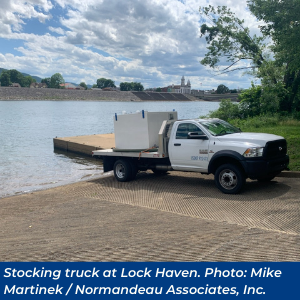 While these results are encouraging, the work of trapping and relocating eels must continue until fish passage technology conducive to volitional eel passage can be implemented at the dams. There are currently fish passage facilities known as fish-ways, at each of the four Hydroelectric Dams on the lower Susquehanna River. Conowingo, Holtwood and Safe Harbor Dams, which are the first three dams moving upriver, have fish lifts or elevators. However, these traditional types of fish lifts are not effective at passing eels. The fourth, York Haven Dam, has a vertical slot fish ladder. As a condition of recertification, dam owners must achieve certain targets for fish and eels passing through and take corrective action if the targets are not met.
While these results are encouraging, the work of trapping and relocating eels must continue until fish passage technology conducive to volitional eel passage can be implemented at the dams. There are currently fish passage facilities known as fish-ways, at each of the four Hydroelectric Dams on the lower Susquehanna River. Conowingo, Holtwood and Safe Harbor Dams, which are the first three dams moving upriver, have fish lifts or elevators. However, these traditional types of fish lifts are not effective at passing eels. The fourth, York Haven Dam, has a vertical slot fish ladder. As a condition of recertification, dam owners must achieve certain targets for fish and eels passing through and take corrective action if the targets are not met.
…But More Work Remains
Equally important to the American Eels lifecycle is downstream passage as they find their way back to the Sargasso Sea. The hydroelectric facilities and their powerful turbines pose a danger to out-migrating eels. Eels can be injured or killed if they pass through a dam’s powerhouse where the turbines are located. The DEP water quality certifications issued for York Haven, Holtwood, and Muddy Run all contain provisions for studying downstream eel passage success and will require measures to successfully pass eels by their facilities.
The Migratory Journey of the American Eel Continues
For many years eels and mussels have been at risk for extinction in the Susquehanna River Watershed in Pennsylvania primarily due to large-scale damming of rivers. DEP and their partners have taken innovative measures to help the eels past these previously impassable roadblocks. These efforts have helped to re-introduce two native species in decline and in so doing, helped to improve water quality in the Susquehanna River and the Chesapeake Bay. This project is yet another example of how DEP partners with other organizations and businesses to help restore our natural resources and provide a cleaner environment for all Pennsylvanians.
